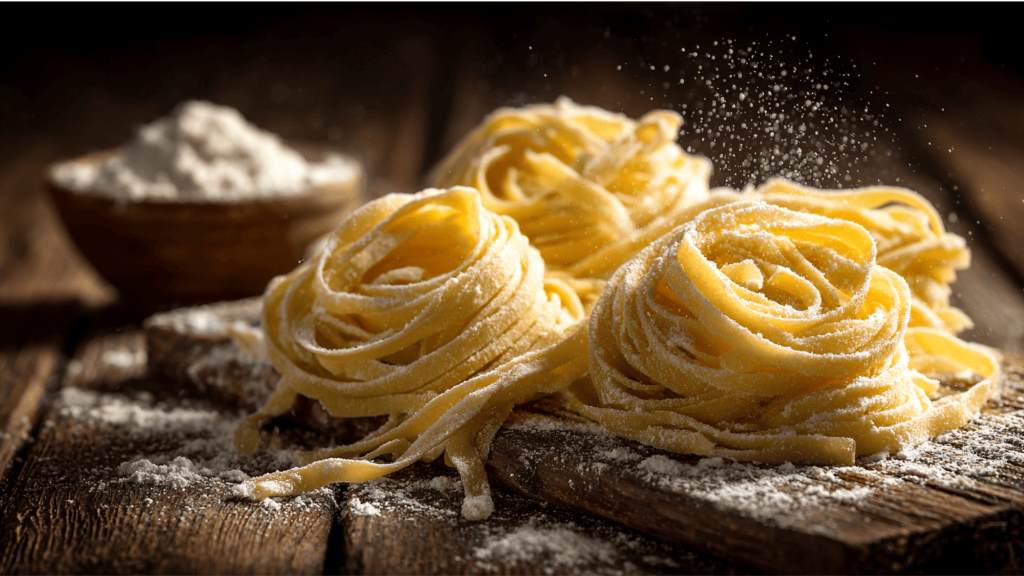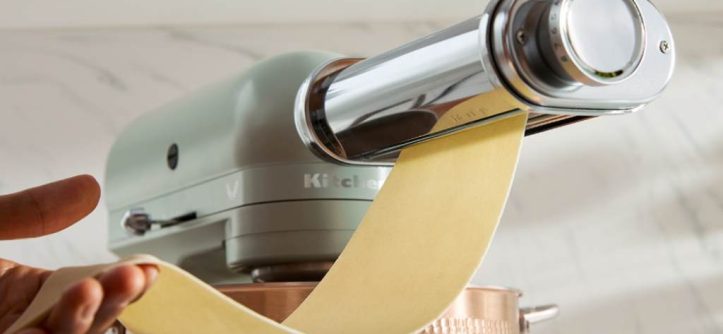Imagine turning simple flour and eggs into silky noodles that taste like Nonna’s Sunday feast. You grab your KitchenAid mixer, attach the rollers, and watch dough transform into perfect sheets. Suddenly, homemade pasta feels easy and fun.
This dough to dinner guide shows you how. People worldwide eat over 15 million tons of pasta yearly, according to FAO data. Italians lead with 23 kg per person annually. Yet homemade versions beat store-bought every time. Fresh pasta absorbs flavors better and offers a tender bite. Plus, you control every ingredient.
Ready to start KitchenAid pasta mastery? Grab the KitchenAid 3-piece pasta roller set. It rolls and cuts like a pro. Let’s dive into Italian pasta basics and create magic.
Why Master Pasta at Home?
Homemade pasta shines brighter than boxed kinds. You skip additives and enjoy pure taste.
Fresh pasta cooks in 2-3 minutes. Dried takes 10-12. That speed saves dinner on busy nights.
You customize everything. Add spinach for green noodles or chili for heat. Kids love helping too.
Studies show fresh pasta has lower glycemic impact when chewed well. It releases energy slowly.
KitchenAid tools make it effortless. No hand-cranking needed. The mixer kneads perfectly every time.
Start small. One batch feeds four. Soon you’ll host pasta parties.

Essential KitchenAid Tools for Pasta Success
Your stand mixer becomes a pasta factory with the right attachments.
The 3-piece set includes roller, fettuccine cutter, and spaghetti cutter. All metal builds last forever.
Attach easily to the power hub. Turn to speed 2 for smooth rolling.
Clean with a brush only. Never submerge in water.
Add a pasta drying rack for nests. It prevents sticking.
Flour your surfaces well. Semolina works best for dusting.
These tools turn beginners into experts fast.
Gathering Top-Quality Ingredients
Great pasta starts with smart choices.
Use “00” flour for silky texture. All-purpose works in a pinch.
Fresh eggs give rich color and flavor. Room temperature mixes better.
Salt enhances taste. Add to dough and cooking water.
Olive oil keeps dough pliable. Just a teaspoon does wonders.
Weigh ingredients for precision. 100g flour per egg is classic.
Try semolina for chewy textures. It adds golden hue.
Store flour in cool, dry spots. Freshness matters most.
Step-by-Step: Crafting Perfect Pasta Dough
Follow this foolproof recipe. It yields 1.5 pounds, serving 4-6.
Ingredients
- 3.5 cups “00” flour (400g)
- 4 large eggs
- 1 teaspoon salt
- 1 tablespoon olive oil
- Water as needed (1-2 tablespoons)
Instructions
Place flour in mixer bowl. Make a well.
Add eggs, salt, and oil. Attach flat beater.
Mix on speed 2 for 30 seconds. Dough looks crumbly.
Switch to dough hook. Knead on speed 2 for 2 minutes.
If dry, spritz water. If sticky, add flour.
Knead by hand 1-2 minutes until smooth.
Wrap in plastic. Rest 30 minutes at room temp.
Resting relaxes gluten. Dough becomes easy to roll.
Divide into 4 pieces. Keep covered to prevent drying.
Attaching and Using the Pasta Roller
Secure roller to mixer hub. Set to 1 (widest).
Flatten one dough piece. Dust with flour.
Feed through rollers on speed 2.
Fold in thirds. Roll again. Repeat 3-5 times.
Increase setting gradually to 5 or 6.
Sheets should feel like thick paper.
For lasagna, stop at 4. Thinner for filled pasta.
Work quickly. Cover unused dough.
Dust lightly between passes. Too much flour toughens pasta.
Cutting Shapes That Wow
Switch to cutters after rolling.
Fettuccine cutter makes wide ribbons. Perfect for creamy sauces.
Spaghetti cutter creates thin strands. Ideal for garlic and oil.
Hang cuts on rack 15 minutes. They firm up.
Make nests for storage. Flour well.
Try hand-cutting for pappardelle. Use pizza wheel.
Experiment with thicknesses. Thicker holds hearty ragu.
Cooks love the control. Every batch looks pro.
Cooking Fresh Pasta to Al Dente Perfection
Bring large pot of water to rolling boil.
Salt generously. 1 tablespoon per 4 quarts.
Add pasta. Stir immediately.
Fresh cooks in 1-4 minutes. Taste for doneness.
Save 1 cup pasta water. It thickens sauces.
Drain gently. Never rinse.
Toss with sauce off heat.
Finish with olive oil or cheese.
Undercook slightly. It finishes in sauce.
Classic Sauces That Elevate Your Creation
Pair shapes wisely.
Long Thin Strands (Spaghetti, Linguine)
Light oil-based or tomato sauces cling best.
Try aglio e olio: Garlic, oil, chili.
Or clams with white wine.
Wide Ribbons (Fettuccine, Tagliatelle)
Creamy or meaty ragu shine here.
Alfredo hugs every strand.
Bolognese simmers hours for depth.
Tubes and Shapes (Penne, Rigatoni)
Chunky vegetable or baked sauces fill holes.
Pesto traps in ridges.
Arrabbiata brings spice.
Filled Pasta (Ravioli)
Butter and sage keep it simple.
Broth for tortellini.
Related:
What’s That Automated Chopper in the Sink Called? Full Explanation Inside
Troubleshooting Your Pasta Journey
Dough tears? Too dry. Add water drops.
Sticky mess? More flour needed.
Uneven sheets? Fold and reroll at wider setting.
Cutter jams? Dough too wet. Dry slightly.
Pasta sticks? Dust more semolina.
Motor strains? Dough too stiff. Rest longer.
First batches teach most. Keep notes.
Practice builds confidence. Soon flaws disappear.
Storing and Freezing for Future Feasts
Dry fresh pasta 1 hour. Then refrigerate 2 days.
Freeze nests on tray first. Bag after solid.
Cooks from frozen. Add 1 minute.
Dried homemade lasts 1 month airtight.
Label with date and shape.
Revive with quick boil.
Never waste scraps. Make maltagliati soup.
Advanced Tips from Italian Traditions
Grandmas knead by feel. Trust touch over timers.
Bronze dies create rough texture. Sauce grips better.
Regional flours vary. Durum for south, soft wheat north.
Ferment dough overnight for deeper flavor.
Infuse with herbs or squid ink.
Pair regionally. Tagliatelle with ragu from Emilia.
Orecchiette with broccoli rabe from Puglia.
Tradition guides but creativity rules.
Health Perks of Homemade Pasta
Control portions easily. Fresh satisfies faster.
No preservatives. Just real food.
Eggs add protein. 15g per serving.
Whole wheat versions boost fiber.
Lower sodium than boxed.
Mindful eating joy. Cooking reduces stress.
Family bonding time. Kids learn skills.
Conclusion
You now hold the keys to KitchenAid pasta mastery. From simple dough to stunning plates, every step brings joy.
Homemade pasta connects us to Italian roots. It feeds body and soul.
Start tonight. Mix that dough. Roll those sheets.
Your kitchen smells like Italy already.
Grab your mixer. Make pasta magic now.
FAQs
How long does fresh pasta dough rest?
Rest 30 minutes minimum. Up to 2 hours improves texture. Wrap tightly.
Can I make gluten-free pasta with KitchenAid?
Yes. Use 1:1 gluten-free flour plus xanthan gum. Roll to setting 4 max.
What’s the best flour for beginners?
“00” flour gives authentic silkiness. All-purpose works fine too.
How do I prevent pasta from sticking when cutting?
Dust generously with semolina. Hang immediately. Work in small batches.
Can I double the recipe?
Yes. Mix in batches. Knead separately for even results.
References
- FAO food consumption data: https://www.fao.org/gift-individual-food-consumption/en/
- KitchenAid official pasta guide: https://www.kitchenaid.com/content/dam/global/documents/200506/owners-manual-9704828-RevC.pdf
- Italian pasta traditions: https://www.recipesfromitaly.com/make-italian-homemade-pasta/
- Sauce pairing principles: https://www.eataly.com/us_en/magazine/how-to/how-to-cook/pair-pasta-with-sauce





Leave a Reply